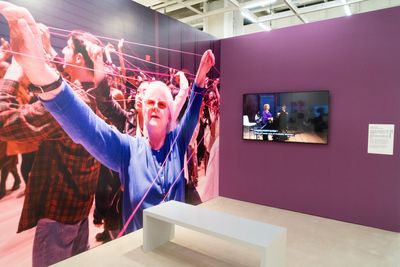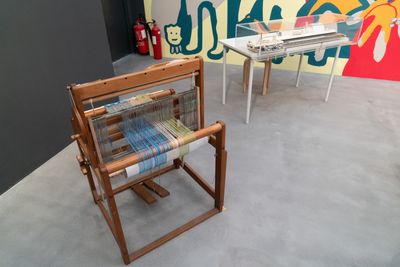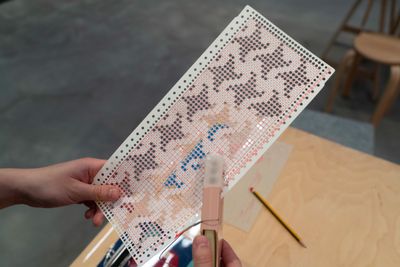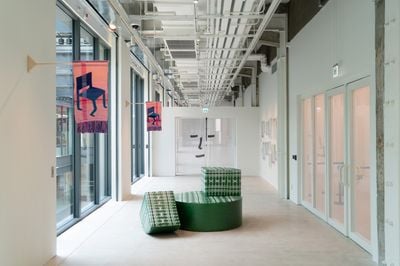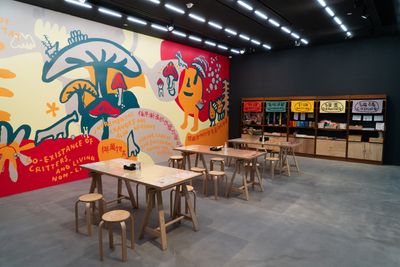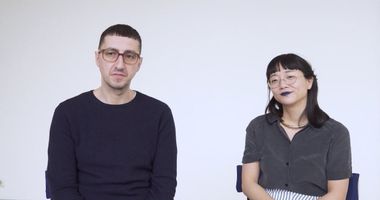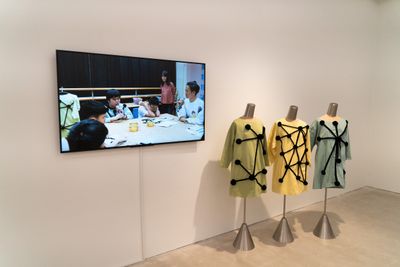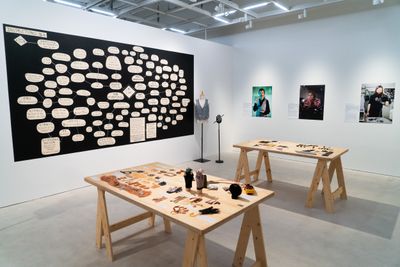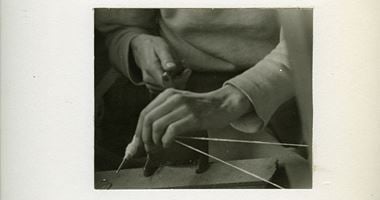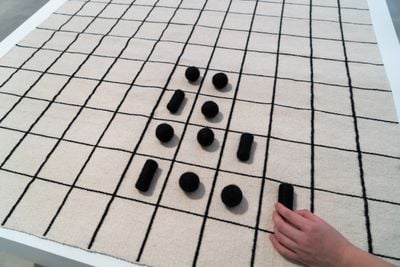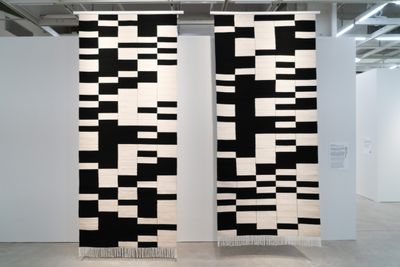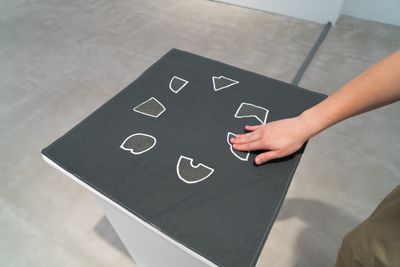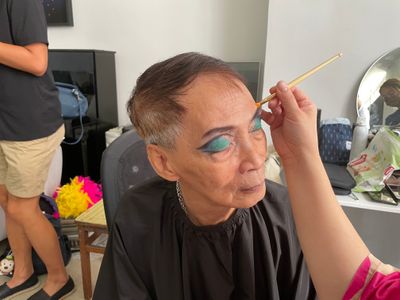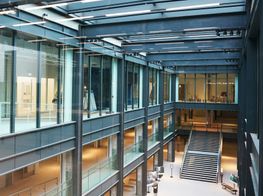Interweaving Poetic Code Links Textiles with Coding
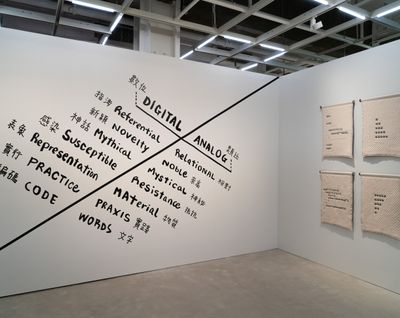
Exhibition view: Interweaving Poetic Code, CHAT (Centre for Heritage, Arts and Textile), Hong Kong (30 April–18 July 2021). Courtesy CHAT (Centre for Heritage, Arts and Textile), Hong Kong.
Interweaving Poetic Code, realised by artistic director Taeyoon Choi and curator Mizuki Takahashi, explored the technical and metaphorical links between textile-making and computer coding, providing alternative pathways into both fields.
While the project centred around an exhibition in Hong Kong at the former cotton spinning mills housing the Centre for Heritage, Arts and Textile (CHAT, 30 April–18 July 2021), it kicked off with a Zoom symposium, Poetic Emergences: Organisation through Textile and Code (16–19 April 2021), that foregrounded the work of weavers, programmers, philosophers, and community workers investigating the transformative processes of textile and code.
Keynote speaker Alexander R. Galloway, a New York-based media studies professor, discussed the innovations of two female mathematicians at the intersection of weaving and computation: Ada Lovelace (1815–1852), who theorised that Jacquard loom punch cards could store data in an analytical machine (i.e. computer), and Ada Dietz (1882–1950), who invented a novel method of using multivariate polynomials to generate weaving patterns.
Moderator Amy K.S. Chan, a Hong Kong-based professor and scholar, introduced Nüshu (literally: 'female script'), a syllabic script that was written and embroidered by women in Imperial China to compose fiction and correspond undetected by male family members.
In 'Session 2: Metaphors of E-Textiles', scholar Annapurna Mamidipudi discussed the PENELOPE project, which aims to integrate ancient weaving into the realm of digital technology, through the lens of her work with handloom weavers in South India. Mamidipudi riled against the pure academicians who confine the practice of weavers as 'some kind of embodied ethno-mathematics that are not universal', and described weaving as a 'technical mode of existence' that performs digital intelligence.
On the unproductive oppositions predominant in epistemology, Mamidipudi stated poetically: 'weaving is digital, weaving is binary (warp and weft), but not oppositional. It is about balance.'
Other speakers discussed projects situated in their communities like Rhys, a Hong Kong-based social enterprise founded by Ophelia Keung and Kadri Keung to create custom-made garments and adaptive clothing for the elderly and the differently abled.
Mok Chiu Yu, a founding member of the Centre for Community Cultural Development—credited with introducing Japanese saori weaving to Hong Kong communities—outlined projects spanning theatrical conferences, touch workshops for the blind, and sign language theatres.
Zainab Aliyu, an artist and cultural worker who works with the School for Poetic Computation in New York, an artist-run school co-founded by Taeyoon Choi to explore the intersections of code, design, hardware, and theory, elaborated on her multimedia installation death as a moment of radical continuity (2019), which revolves around a woven interactive circuit board, an opele divination chain from her Yoruba heritage, and digital family archives.
At the centre of this poetic vision of care is Taeyoon Choi, a 2019 CHAT artist-in-residence and artistic director of Interweaving Poetic Code. At the entrance to the exhibition at CHAT, Choi's Interweaving Poetic Code Flag comprised a set of 14 Jacquard knitted fabrics introducing the characters of the exhibition alongside a poem composed of binary code.
Across the walls of the galleries, Choi's playful and childlike inscriptions formed the show's visual identity: cutesy graphics and smiley human figures underlining a methodology of demystification and unlearning.
Toy-like 8-byte hand-built circuit boards and little servers formed a material internet garden where viewers could participate by joining a local network with their avatars appearing in projection, demonstrating how acquiring knowledge is fun, hands-on, and unintimidating.
Choi's singular intention of transforming dauntingly complex topics into graspable and delectable experiences came through in video documentation of interventions like CPU Dumplings (2018/2021), a dumpling-making workshop where participants took the roles of different workstations modelled after the operations of a CPU (Central Processing Unit) with dumplings as their output.
To use weaving as a tool to transform the social fabric is a key theme across Interweaving Poetic Code...
This playful unwieldiness might prompt a viewer programmed for a certain kind of curatorial experience—a 'normal' exhibition, so to speak—to initially resist Choi's modus operandi, focused as it is on intentionally subverting traditional systems of display, not to mention authorship.
In keeping with the idea that a work should not function as a closed circuit as much as an open participatory situation, Choi's contemporaries were invited to participate in the show. Among them were architect and artist Andreas Angelidakis and Christine Sun Kim, with whom Choi collaborated on FUTURE PROOF (2016), a workshop inviting audiences to collectively activate a set of seven 'future' wind chimes.
To use weaving as a tool to transform the social fabric is a key theme across Interweaving Poetic Code, with workshops like Touching the Internet (2019) at the Ebenezer School and Home for the Visually Impaired inviting students to learn about the internet through tactile experience and recreate their own networks by sewing textile materials and objects.
In the work of KOBAKANT and Amor Munoz, e-textiles emerged as a radical site for remaking open futures. An artist collective formed by Mika Satomi and Hannah Perner-Wilson, KOBAKANT hacks electronics and textile crafts to realise the needs of individuals. In addition to running workshops and an online database with DIY resources, KOBAKANT has a storefront in Berlin that provides bespoke consultation and tailor-made services for people.
For the exhibition, KOBAKANT recreated KOBA Electronic Textile Tailor Shop (2017–2019), with mannequins donning custom-made clothing, a wall-sized mind map with guiding questions, and tables displaying myriad fabric materials and electronic parts.
Videos on display presented previous KOBAKANT projects: a storyteller's vest that flashes with colour patterns, a hoodie augmented with an EMF listener circuit, and a crocheted drape that senses a dancer's movements.
Amor Munoz's Coded Textile I & II (Matter and Memory) (2018–2020) takes inspiration from the computer memory systems of the 1950 and 60s, where tiny magnetic cores are laid out in a grid system, threaded with copper wires.
Taking a cue from Anni Albers, Munoz enlarges this systemic grid into a tapestry, with each row becoming a five-bit datum (25=32 permutations) that corresponds to one of 26 letters in the English alphabet. Viewers could decode the woven message with the provided five-bit binary cipher, similar to how a CPU would access memory stored in the magnetic core.
Munoz highlights the materiality of computing, and how technological evolution has always been a means to human ends. In keeping, weaver and academic Laura Devendorf champions what she describes as 'a necessary frustration' in the user's process of discovery in the modelling of quotidian life.
A Fabric that Remembers (2019) is a woven tapestry with embedded electronics that react to the pressure of touch. When viewers press onto the patch, a digital screen records and displays corresponding areas lit up in a shade of red proportional to the pressure applied.
In Wear (2020–2021), Devendorf applies this principle to design a garment that records the extended touch of her young children over the past year. This time, cotton fibre coils dyed with thermochromic pigments change colour where body heat is recorded.
Quoting Judy Wajcman in TechnoFeminism (2004), 'Promises of emancipation from the frailties and failings of mortal flesh have reached a new crescendo in the cyberspace age.' Interweaving Poetic Code subverts this illusory promise by grounding craft in visceral expressions that entangle the body with care, curiosity, and love.
The final jewel of the programme was Access Breach – Radical Visibility Ball, a collaboration with Rebirth Garments, which provides custom-made garments and accessories for people and activists who are trans, femme, masc, gender non-binary or non-conforming, plus-size, wheelchair-user, visually impaired, and aged.
Rebirth Garments is the brainchild of Sky Cubacub, a non-binary queer and disabled Filipinx human from Chicago who believes that rebirth is a form of poetic emergence and seeks to share that experience with those that seek it.
Held at Eaton HK on 2 July 2021, Access Breach was an exuberant event of music, dance, bodies, colours, and forms that combined fashion with ballroom culture. Sky Cubacub's insignia, an evolved circular queercrip symbol, appeared on the seven models chosen wearing tailor-made garments showcasing body parts they wished to highlight.
Models sashayed in form-fitting elastics and flowing gowns, confidently flaunting their existence. Opposing houses from the nascent ballroom scene in Hong Kong converged and battled in full regalia. Everyone danced without shame, no longer passing, assimilating, or hiding, but affirming all bodies as complete, wholesome, and workable. —[O]

